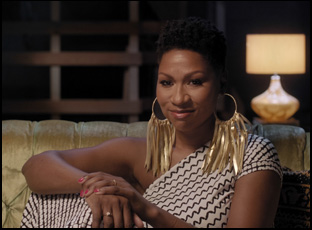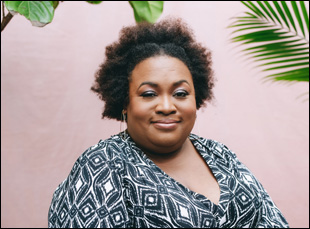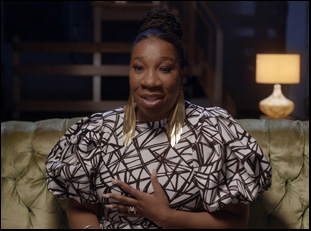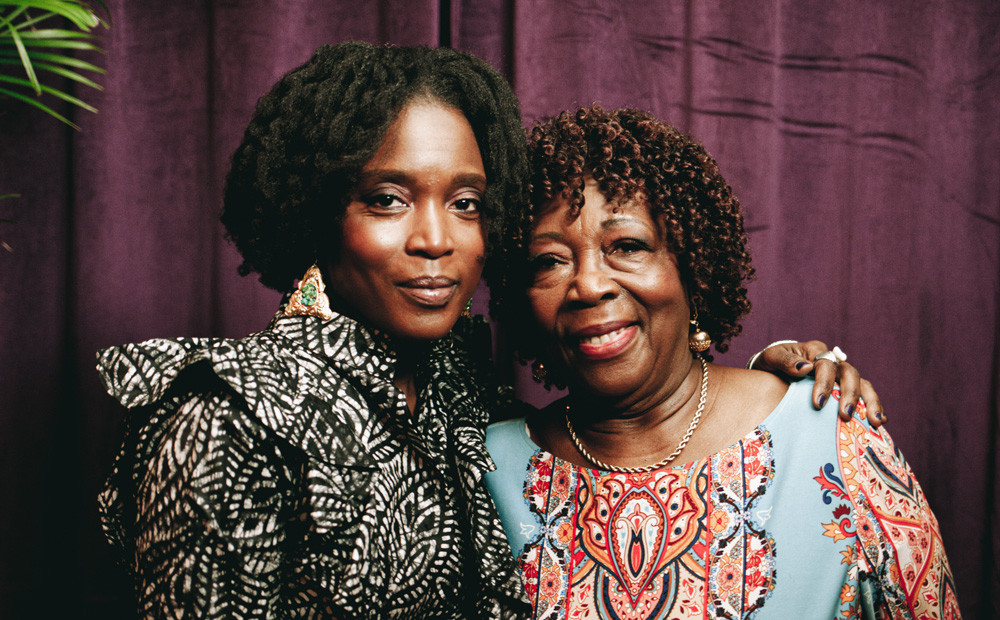It hadn’t been how it was planned, but given that Shantrelle P. Lewis had always hoped to make it feel like home for audiences to get into the kind of intimate conversations she wanted in her debut film “In Our Mothers’ Gardens,” there was a silver lining when Blackstar, a festival where she had been a founding board member, pivoted online last fall due to the coronavirus pandemic.
“You lose that experience of being in a theater and seeing people’s reactions of like, ‘Oh, good, they laughed at the part that I wanted or they cried at the part,’” says Lewis. “But it allowed so many other people to have access to the film that otherwise wouldn’t because the festival is held in Philadelphia every year, so that’s what was most exciting and thrilling for me and then I was able to engage with people on social media, which allowed them to be a part of the experience.”
“In Our Mothers’ Gardens” could hardly be confined to a single screen anyway, unfolding as a sprawling ongoing conversation that fittingly begins with Lewis asking those she talks to to take a deep breath before diving in. Assembling a collection of Black women of excellence to reflect on their roots, the film engages the likes of #metoo founder Tarana Burke, Dr. Brittney Cooper of Rutgers and tour manager Tina Farris, among others, to discuss their lives now and the families that raised them, swapping the kinds of stories that usually only close friends know. Lewis, who has built a career as both a cultural critic and curator tracing the history of African diaspora and how it has manifested itself into the arts, creates something wholly unique as she puts the oral histories she receives into a larger context, offering up playful history lessons to accompany the heartfelt personal testimonies that may describe hardship but always come from a place of perseverance.
With the film available to stream on Netflix via ARRAY, the opportunity to spend time with these remarkable women is now within immediate reach as is all the history they bring along with them, and Lewis recently spoke about how she was moved to embark on such a project, how her background as a curator informed how she went about filmmaking and bringing her experience into the film more generally.

My storytelling journey began with me being a little girl in New Orleans listening to my dad telling me these outrageous stories about growing up in the Lower Ninth Ward. My grandparents had 12 kids and my dad was a middle child, so I’m sure his imagination was wild. He would tell me these crazy, outlandish stories and I’m like, “I don’t believe this guy, but he was like, “I’m telling you girl, go ask your grandpa.” So I would go ask my grandfather, “Grandpa, daddy told me… Is this true?” And he would embellish upon what my dad said or he would tell me the correct version of the story or the version he wanted me to hear, so I came from a family of storytellers. Genealogy, family history, and lineage was big for my family.
In New Orleans, our cemeteries are these mystical, magical places, and I’ve always gone to the cemetery to spend time with my ancestors. Then later, I started practicing African spiritualism where ancestor veneration was central to who we are, but it was really over the past few years, really having to sit down and reckon with my relationship with my mom and try to understand her story in order to understand myself. Like Alice Walker in her groundbreaking book, “In Search of Our Mother’s Gardens,” she says, “I went in search of my mother’s garden so that I could find my own.” That’s essentially what I did. I had to go and ask those questions that we don’t normally like to talk about with our parents, the questions they don’t like to answer. And it was that really messy work of trying to understand my mama in order to understand myself. That’s where this story began.
Besides yourself, did you know pretty immediately who you thought you should talk to for the film?
In my work, which I identify as African-centered and also diasporic, it’s important for me to tell a story that any Black woman anywhere could relate to, so it’s not just someone living in Chicago or St. Louis or Brooklyn or Miami, but if a black woman was in London or South Africa or South America, she could find herself in the story. So I wanted a diverse range of Black women from around the diaspora — I wanted a range of ages, and I admittedly focused on Gen Xers and baby boomers because I am a Gen Xer and my mom’s a boomer. But I wanted different accents to be present. I’m from New Orleans, so my accent tends to overpower everyone else’s and people are always asking me, “Where are you from?” Or they’re trying to place where I’m from. So it was also really important that there was geographical representations, even in how people spoke and their dialect and their accents and I turned to my community of friends. I have this cornucopia network that is rooted and grounded in Howard University’s alumni networks, so I started there in deciding who I wanted to talk to.

I was excited about the similar threads that were happening in a lot of the conversations. There were so many funny and adventurous stories, so it wasn’t just stories rooted in trauma, but there was also lots of laughter and you don’t have to be a daughter, you don’t have to be a woman, you don’t have to be Black to see yourself in this film or to relate. It’s a story about family. And what I’ve heard from people who have seen the film is that they want to go get on the phone and call their mom, if their mom is still with them, or they want to go and dig in the family archives and look up old photos and ask questions — “tell me about my grandparents and how they met. Tell me your story.” That’s really my hope with the film.
One of the things that I loved about this so much, and you can take this any way you want it because it applied to both the editing and the production of it is I just love how you give these women space to talk, both in front of the camera and the time you’re giving them to speak without cutting away. What was it like figuring out the presentation for this?
That was a step-by-step process, and I leaned back onto my curatorial process of how I would organize visual art exhibits, so it was piece by piece, [asking] what’s the mood? What’s the intention behind it? What’s the context behind what I’m doing? What do I want the outcome to be? I’m not from that school of [thinking] as a curator you’re supposed to be objective. My curatorial practice is very non-traditional, nonlinear and very African-centered. It was circular, so context was always at the center of the territorial work that I did and the same thing happened with this film, so I wanted to use those comedic moments and the collage and [the idea of] how I can incorporate different types of footage and different types of shots into the film. How could I bring art or other mediums into the film? That part was fun for me and I really have to thank my editor, Sheniqua Lewis, who was willing to indulge in my fantasy. When I was like, “I want to insert this commercial in the film,” she went and found the jingle from the ‘50s for the Nap Ministry rest ad, so it was a lot of fun working with her and her working with me to bring my vision to life.

I did! Talking about network, I turned to my friend Bouba Dola, an amazing, out-of-this-world Congolese filmmaker who’s been living in the Netherlands most of his life, and he does lots of animation, so I enlisted him to bring my grandparents to life because that’s how I remember them. It’s my grandmother trying to watch her soap operas, my grandfather hooping and hollering, banging on the wall asking for his Ensure. It was just a loud, lively environment, and I wanted to have the audience experience what it felt like growing up and being in my grandparents’ home.
Quite literally, you spend a lovely afternoon at the home of Dr. Koko Zauditu Selassie, which is a bit of a stylistic break from the film in that she’s preparing a Saturday lunch and takes audiences around her house. How did that come into the picture?
Well, Dr. Koko or Mama Koko, as we affectionately call her, is one of my former graduate professors at Temple and she taught me African religion. She’s also an elder priest in my spiritual house, so she’s my elder god sister and I knew that she spent so much of her life and career as a Fulbright scholar traveling back and forth to Africa, to the Caribbean, to South America, so she’s a living, walking, talking museum herself and her house is an artifact, and when I had the opportunity to make the film longer — [which] was during COVID, so I could not bring her into a studio — [I thought] how can I add some verite footage to the film and bring the audience to her? To see her altars, to see her dolls, to see her jewelry, because we practice art. Art is not just for the wall, for the white box. But in our tradition, we live art. It’s functional. It has purpose and has meaning in our lives that go beyond aesthetic pleasure. So that was really exciting. I just didn’t just want a bunch of talking heads [in the film]. And the camera crew was blown away. They’re just like, “Oh my God, who is this person?” So I’m really excited for audiences to meet Mama Koko as well.




